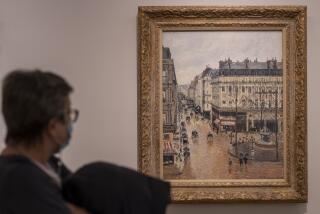Roundup: A Rembrandt returns, finding Mary Ellen Mark’s iconic smoking girl

“Saul and David,” a painting that has been sliced and painted over, has been reattributed to Rembrandt. It is now on view at the Mauritshuis art museum in The Hague.
An artist is ordered by a court to make it big. The European parliament is set to vote on the right to take and share pictures of public monuments. A reporter finds the young girl from an iconic 1990s photograph. Plus: the charmingly bananas history of LACMA’s Art and Technology program, what Cuban artist Tania Bruguera’s work might signify (both politically and artistically), and a battered Rembrandt reemerges in the Netherlands. Here’s the Roundup:
— The European Parliament will vote next week on whether the public has a right to freedom of panorama — that is, the right to freely take and share pictures of public monuments. My take: Public space is public space. If you put a monument in it, the public should be able to take a picture and distribute it. (H/T @notrobwalker)
— Speaking of copyright issues, a photography show of work by Yale MFAs (soon to go on view at Regen Projects in West Hollywood) has generated some controversy after it was revealed that one of the works is based on an appropriated image made by a pair of young female artists.
— A Danish judge has ordered artist Danh Vo to make a “large and impressive” work for a collector, after the collector rejected a smaller piece made out of cardboard and gold leaf. Vo says he will appeal. If this weren’t real, I’d say it was a Monty Python skit as imagined by Jeff Koons.
— Related: The big problem for all those 1% art collectors is that the art they buy is too big to fit in the house. Solution: Get a bigger house. Also, BYOM (build your own museum).
— A famous 1990 photo by Mary Ellen Mark showed a 9-year-old with fake nails smoking in a pool. NPR tracks down the girl. (ArtsJournal)
— “They’re very 1953 … You know, like the girls wear too much underwear.” That’s crushed car sculptor John Chamberlain talking about his residency at the Rand Corp. in the 1960s, courtesy of LACMA’s Art and Technology program. Catherine Wagley has a fascinating, well-written history and analysis of the program on East of Borneo. A great read!
— A smart piece by the Washington Post’s Nick Miroff on dissident Cuban artist Tania Bruguera and what her work might or might not mean in the current political context.
— Missing statues adored by Hitler reemerge in Germany.
— The Milwaukee Art Museum has acquired a controversial piece showing Pope Benedict made out of condoms.
— On both coasts, works employing Confederate flags: New York artist Sonya Clark partially unraveled a flag as part of an installation at a New York gallery that predates the June 19 attack in Charleston, S.C., while the Laguna Art Museum is showing collaged canvases by G. Ray Kerciu, inspired by the artist’s experiences at the University of Mississippi during desegregation.
— Related: You can remove the flag, but the South is still littered with monuments to the Confederacy.
— Renzo Piano’s alien death star at the Academy of Motion Picture Arts & Sciences Museum gets a thumbs-up from the City Council’s planning and land use management committee.
— Miriam Schapiro, the pioneering feminist artist who helped establish the feminist art program at CalArts, who organized Womanhouse with Judy Chicago in L.A. in 1972, and who elevated pattern and craft into high art, died last week. William Poundstone remembers her with a good quote.
— Despite being chopped up and painted over, a Rembrandt reemerges in The Hague.
— A photographic chronicle of L.A.’s small churches.
— How an art project helped desegregate a Georgia prom.
— Some worthwhile (if terrifying) photo essays: life in North Korea and neo-Nazis in Riverside.
— An incredible animated graphic that shows the entire history of the trans-Atlantic slave trade in two minutes. Just, wow.
— Architecture critic Mark Lamster on the way race has been “coded into the physical framework of Dallas.”
— And last but certainly not least … if for some reason you missed President Obama’s eulogy for S.C. state Sen. Clementa Pinckney, who was among those killed in Charleston, be sure to watch the whole thing. I’m not generally into political speechifying, but this is a wondrous, historic speech, full of profound themes and an artful use of the English language. Not to mention, song, as my colleague Steve Zeitchik observed in his take on Obama’s ‘Amazing Grace’ moment.
Find me on Twitter @cmonstah.
More to Read
The biggest entertainment stories
Get our big stories about Hollywood, film, television, music, arts, culture and more right in your inbox as soon as they publish.
You may occasionally receive promotional content from the Los Angeles Times.







